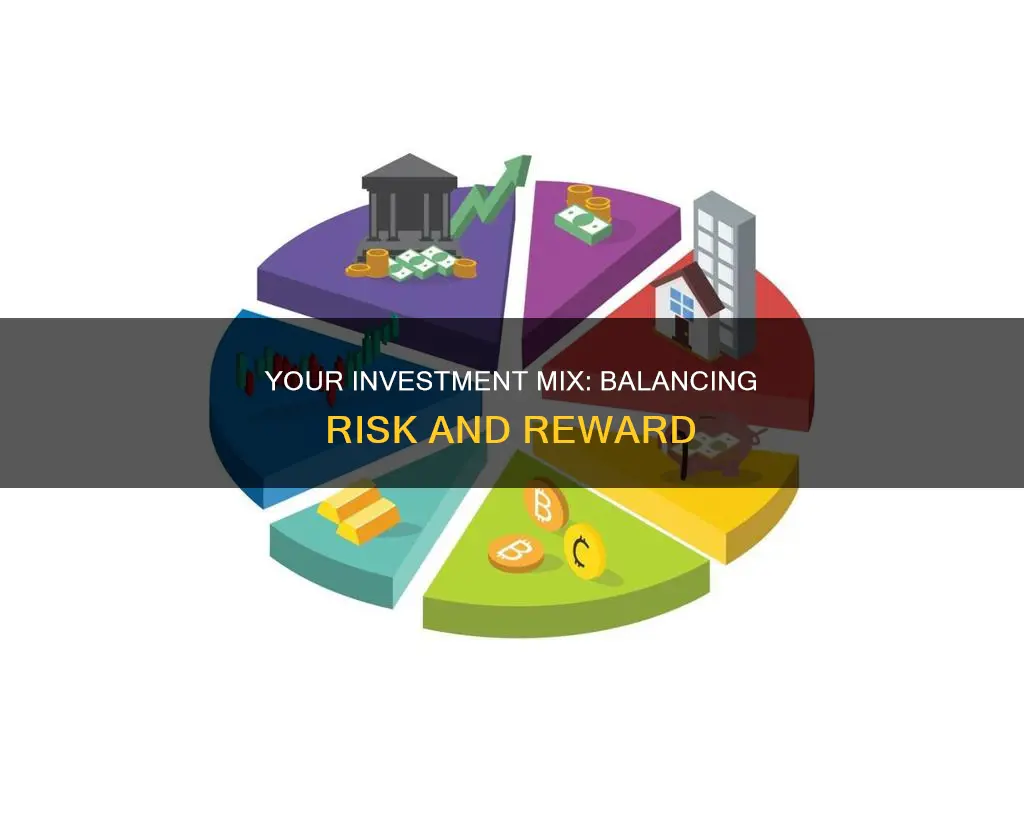
Finding the right mix of investments is a complex and often confusing task. It involves determining your financial goals and the amount of money needed to achieve them. This includes taking into account factors such as your age, risk tolerance, and investment horizon. The right mix typically includes a combination of stocks, bonds, and cash, known as asset allocation. For example, younger investors with a longer time horizon might opt for a portfolio that is heavier on stocks, while older investors approaching retirement might prefer a more conservative mix with a larger proportion of bonds and cash. Additionally, it is important to diversify your investments across different sectors, company sizes, and geographic regions to minimise risk and maximise returns.
| Characteristics | Values |
|---|---|
| Age | Younger investors can afford to take more risks and invest mostly in stocks, whereas older investors should have a portfolio that is lighter on stocks |
| Risk capacity | If there is little to no gap between expected spending and income, risk capacity is high. If the gap is wide, the capacity to withstand investment losses and the ability to take investment risk is low |
| Risk tolerance | Psychological ability to handle losses without panic |
| Time horizon | Short-term investors use bonds or cash to preserve their money; long-term investors rely on higher-returning stocks; intermediate-term investors should use a mix of stocks and bonds |
| Asset allocation | The mix of stocks, bonds, and cash in a portfolio. Tools are available to help determine the right asset allocation |
| Diversification | Spreading money across different kinds of investments to reduce overall risk |
What You'll Learn

Stocks, bonds, and cash
Stocks
A stock, also known as an equity security, represents a share of ownership in a company. There are a few basic types of stocks, including large-cap, mid-cap, small-cap, and international. Large-cap companies have market capitalizations starting at $10 billion, mid-cap companies range from $2 billion to $10 billion, small-cap companies are between $300 million and $2 billion, and international stocks refer to foreign (non-US) companies. There are also two primary classes of stock: common stock and preferred stock. Common stock is the type that is typically bought when investing in a company, and it usually entitles owners to voting rights and the potential to receive dividends. Preferred stock is less volatile and acts more like a bond, providing a fixed yield and less potential for total return.
Bonds
A bond is like an IOU. You lend money to a borrower and receive a promise of repayment, plus interest, at a set date. Bonds have varying degrees of risk depending on the type. Corporate bonds, for example, offer the highest yield but also carry the highest risk. Municipal bonds, or "munis", are issued by state or local governments and are popular among investors in high tax brackets as they are usually not subject to federal taxes. Government bonds are considered the safest debt instruments and are issued by the US Treasury or other federal agencies.
Cash
Cash and cash investments are low-risk and offer lower returns, making them suitable for shorter-term goals, day-to-day expenses, and emergency funds. Examples include checking and savings accounts, shorter-term CDs and T-bills, and longer-term CDs. While keeping money in cash is liquid and easily accessible, it can present inflation risk over the long term as the low returns may be lower than the rate of inflation. Therefore, it is recommended to stick to the percentage of cash specified in your asset allocation plan and maintain an emergency fund of at least three to six months' living expenses.
Determining the Right Mix
The right mix of stocks, bonds, and cash depends on various factors, including your financial goals, time horizon, risk tolerance, and life circumstances. If you are investing for the long term, you may rely more on stocks due to their higher potential returns, whereas shorter-term investors may favour the preservation of capital offered by bonds and cash. Your age can also be a factor, with younger investors typically having a higher allocation of stocks and gradually shifting towards bonds as they get older. However, it is important to consider your individual risk tolerance and financial situation when determining your asset allocation.
Apple: Invest Now or Miss Out?
You may want to see also

Risk capacity and risk tolerance
Risk tolerance refers to an individual's psychological willingness to take on risk. It is about emotional and psychological comfort with risk and is influenced by factors such as age, gender, income, personality, past experiences, and behavioural biases. Risk tolerance can change over time due to life events, age, and economic conditions. It is important to understand one's risk tolerance to ensure that the level of risk in one's investment portfolio aligns with their emotional comfort zone.
On the other hand, risk capacity relates to the financial ability to endure potential losses. It is determined by concrete financial circumstances such as income, debt, assets, liabilities, insurance coverage, dependents, and time horizon. Risk capacity can be measured objectively and provides a tangible boundary on the level of risk one can afford to take.
While risk tolerance is subjective and emotional, risk capacity is more objective and financial. However, both factors are crucial for crafting a balanced and effective investment strategy. Achieving harmony between risk tolerance and risk capacity is essential for financial peace of mind.
For example, consider two investors, Sam and Penny, who are both considering investing $100,000 into a diversified stock portfolio. Sam has a high risk tolerance; she is comfortable with the volatility associated with stocks and sees it as an opportunity for higher long-term gains. On the other hand, Penny has a lower risk tolerance; she gets anxious about the possibility of losing money and wants to preserve her capital. Despite the potential for higher returns, she wants to limit her risk exposure. Their different risk tolerances would lead them to make different investment choices, with Sam investing in higher-risk growth and speculative stocks, while Penny opts for more conservative stocks with lower potential returns.
In addition to risk tolerance, it is important to assess one's risk capacity. Risk capacity determines the level of risk one can realistically afford to take in their investment strategy. It is influenced by factors such as income, assets, liabilities, debts, insurance coverage, and time horizon. By understanding both their risk tolerance and risk capacity, investors can make more informed and aligned investment choices.
To achieve a harmonious balance between risk tolerance and risk capacity, individuals can take several strategic steps. These include undertaking a thorough self-assessment and seeking professional guidance, constructing a balanced portfolio that respects both the investor's emotional comfort and financial reality, regularly reviewing and adjusting their financial plan and investment strategy, enhancing their financial literacy, and diversifying their investments across various asset classes to manage risks.
Target: Invest Now or Miss Out?
You may want to see also

Short-term vs long-term goals
When it comes to investing, it's important to consider your short-term and long-term goals, as these will influence the mix of investments that's right for you. So, what's the difference between short-term and long-term investing?
Short-term investments are typically held for one year or less, with most investors holding them for a few months, weeks, or even days. These investments are often volatile assets with high liquidity, allowing investors to profit from short-term price movements. Stocks, options, and ETFs are common choices for short-term investors. This strategy suits those with short-term financial goals, such as building an emergency fund or saving for a large purchase like a car or a home down payment.
On the other hand, long-term investments are typically held for more than a year, with many investors holding them for several years or even decades. These investments are expected to gain value slowly but steadily over time. Examples include real estate, mutual funds, and bonds. Long-term investments are common in retirement accounts and college funds, where the focus is on slow but steady growth rather than short-term gains.
Now, let's talk about the right mix of investments for your goals. If you're focused on short-term goals, you may want to consider less risky options such as certificates of deposit (CDs), high-yield savings accounts, or short-term bonds. These provide stable returns and are ideal if you want to ensure your money is there when you need it in the short term. However, they may not offer the same high returns as riskier investments like stocks.
For long-term goals, such as retirement or saving for a child's education, you'll typically build a balanced portfolio that includes a mix of stocks, bonds, mutual funds, and exchange-traded funds (ETFs). This type of portfolio can weather short- to medium-term market fluctuations and provide solid returns over time. Additionally, long-term investments can benefit from compound interest, where interest accrues on both the principal balance and any earned interest, leading to exponential growth over time.
It's worth noting that the Internal Revenue Service (IRS) taxes short-term and long-term investments differently. Short-term investments held for a year or less are taxed as regular income, while long-term investments held for more than a year are taxed at lower capital gains rates. Therefore, holding investments for the long term can result in significant tax savings.
In conclusion, whether you're investing for the short or long term, it's crucial to understand your goals, risk tolerance, and time horizon. A mix of both short-term and long-term investments can lead to a diversified portfolio that helps you achieve your financial objectives.
Americans: Investors or Not?
You may want to see also

Mutual funds
There are four main categories of mutual funds: money market funds, bond funds, stock funds, and target date funds. Each type has different features, risks, and rewards.
Money market funds are considered low-risk as they can only invest in certain high-quality, short-term investments issued by U.S. corporations and governments. Bond funds, on the other hand, have higher risks as they aim for higher returns. Stock funds invest in corporate stocks and can be further categorized into growth funds, income funds, index funds, and sector funds. Lastly, target date funds hold a mix of stocks, bonds, and other investments, gradually shifting the mix over time according to the fund's strategy.
When choosing the right mix of mutual funds, it is essential to consider your investment goals, time frame, and risk tolerance. A well-diversified portfolio should include a mix of stocks, bonds, and cash, with the percentage of each depending on your risk tolerance and investment objectives.
- Calculate your investing budget: Determine how much you can consistently invest each month towards your retirement or other financial goals.
- Open tax-advantaged retirement accounts: Utilize tax-advantaged accounts such as a workplace 401(k) plan or a Roth IRA to maximize your investment returns.
- Pick the right mix of mutual funds: Diversify your portfolio by investing in different types of mutual funds, such as growth and income, growth, aggressive growth, and international funds.
- Understand mutual fund lingo: Familiarize yourself with investment terms like asset allocation, cost, large-cap, medium-cap, small-cap, performance, portfolio, sectors, and turnover ratio.
- Work with a financial advisor: Consider seeking guidance from a financial professional who can help you choose the right mutual funds and stay engaged with your investment strategy.
By following these steps and staying informed about mutual funds, you can make more confident decisions about your investments and work towards achieving your financial goals.
NIO Stock: Buy or Bye?
You may want to see also

Index funds
When investing in index funds, it is important to consider your goals, risk tolerance, the fees you are willing to pay, and the length of time you are willing to invest your money for. It is also wise to research different funds to understand their performance history, management fees, and the indexes they track.
Overall, index funds offer a simple, low-cost way to gain exposure to a broad, diversified portfolio, making them a good option for both beginner and expert investors.
College: A Risky Bet?
You may want to see also
Frequently asked questions
The right mix of investments depends on your age, goals, and risk tolerance. Generally, younger people can invest more in stocks, while those closer to retirement should have a portfolio that is lighter on stocks and includes bonds and cash.
Asset allocation refers to the mix of stocks, bonds, and cash in your investment portfolio. This mix should be chosen wisely as it will do most of the work for you.
To determine your asset allocation, you need to consider your financial goals and how much money you need to meet them. You can use asset allocation tools to find the mix that will help you achieve your goals. It is also important to consider your risk capacity and risk tolerance. Risk capacity is dictated by assets, sources of income, and spending, while risk tolerance refers to your emotional ability to handle losses.







